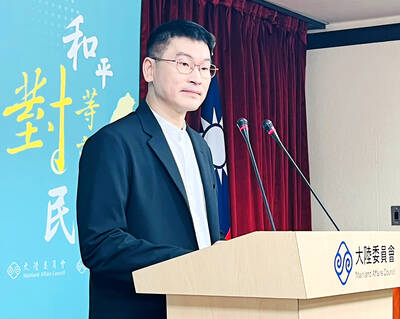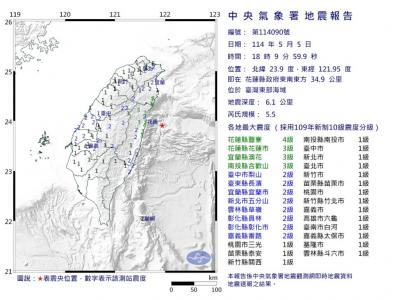Relatives of victims of the 228 Massacre yesterday criticized former premier Hau Pei-tsun (郝柏村) over his comments that only about 500 people — instead of the commonly seen estimates of between 20,000 and 30,000 — were killed during the massacre, calling it a baseless rewriting of history.
“What Hau said in a letter to the editor [published in the Chinese-language United Daily News on Tuesday] about the 228 Massacre is unacceptable, because his statement was seriously biased, and was a complete betrayal of historic facts,” said Democratic Progressive Party Legislator Lee Chun-yi (李俊俋), who accompanied victims’ families in a news conference at the legislature.
“What happened then created pain that has forever been buried in the hearts of the victims’ families, and what Hau did was tantamount to rubbing salt into their wounds. [His words] could trigger ethnic tensions in the country,” Lee said.
In his op-ed, Hau said textbooks were mistaken in their claims that more than 10,000 people were killed during the 228 Massacre, adding that according to his understanding, only a little more than 500 people were killed in the crackdown on the uprising.
Lin Li-tsai (林黎彩), the daughter of a 228 victim and the secretary-general of the 228 Care Association, took out a copy of the Research Report on the 228 Incident published by the Executive Yuan in 1991 and called Hau a liar.
“The official report says that between 18,000 and 28,000 people were killed during the massacre — the research was conducted by the Executive Yuan, and the report was published by the Executive Yuan,” Lin told the news conference. “And you, Hau Pei-tsun, were the premier at the time.”
“Are you trying to deny something that the Executive Yuan under your leadership had concluded?” she asked.
Another victim’s relative, Yang Chen-jung (楊振榮) said President Ma Ying-jeou (馬英九) was using the 228 Massacre to make political gains, adding that he should show some real compassion instead.
“Four years ago, you [Ma] said you would dig out all the facts about the tragedy. Well, four years later, serving as both the head of state and of the ruling KMT, [what have you done]? What really happened, who was really killed and where are the missing people? These all still remain a mystery,” Yang said.
The 228 Massacre refers to an nationwide uprising against the Chinese Nationalist Party (KMT) regime that broke out on Feb. 27, 1947, two years after the KMT took over Taiwan, because of government corruption and economic hardships under the KMT.
At first, those fighting the KMT won the upper hand. However, the uprising was violently crushed when the regime sent troops from China.
Since the majority of the population in Taiwan at the time were native Taiwanese, while the ruling elite and soldiers were mostly from China, the massacre triggered ethnic tensions and it has sometimes been considered an ethnic conflict.

An essay competition jointly organized by a local writing society and a publisher affiliated with the Chinese Communist Party (CCP) might have contravened the Act Governing Relations Between the People of the Taiwan Area and the Mainland Area (臺灣地區與大陸地區人民關係條例), the Mainland Affairs Council (MAC) said on Thursday. “In this case, the partner organization is clearly an agency under the CCP’s Fujian Provincial Committee,” MAC Deputy Minister and spokesperson Liang Wen-chieh (梁文傑) said at a news briefing in Taipei. “It also involves bringing Taiwanese students to China with all-expenses-paid arrangements to attend award ceremonies and camps,” Liang said. Those two “characteristics” are typically sufficient

A magnitude 5.9 earthquake that struck about 33km off the coast of Hualien City was the "main shock" in a series of quakes in the area, with aftershocks expected over the next three days, the Central Weather Administration (CWA) said yesterday. Prior to the magnitude 5.9 quake shaking most of Taiwan at 6:53pm yesterday, six other earthquakes stronger than a magnitude of 4, starting with a magnitude 5.5 quake at 6:09pm, occurred in the area. CWA Seismological Center Director Wu Chien-fu (吳健富) confirmed that the quakes were all part of the same series and that the magnitude 5.5 temblor was

The brilliant blue waters, thick foliage and bucolic atmosphere on this seemingly idyllic archipelago deep in the Pacific Ocean belie the key role it now plays in a titanic geopolitical struggle. Palau is again on the front line as China, and the US and its allies prepare their forces in an intensifying contest for control over the Asia-Pacific region. The democratic nation of just 17,000 people hosts US-controlled airstrips and soon-to-be-completed radar installations that the US military describes as “critical” to monitoring vast swathes of water and airspace. It is also a key piece of the second island chain, a string of

The Central Weather Administration has issued a heat alert for southeastern Taiwan, warning of temperatures as high as 36°C today, while alerting some coastal areas of strong winds later in the day. Kaohsiung’s Neimen District (內門) and Pingtung County’s Neipu Township (內埔) are under an orange heat alert, which warns of temperatures as high as 36°C for three consecutive days, the CWA said, citing southwest winds. The heat would also extend to Tainan’s Nansi (楠西) and Yujing (玉井) districts, as well as Pingtung’s Gaoshu (高樹), Yanpu (鹽埔) and Majia (瑪家) townships, it said, forecasting highs of up to 36°C in those areas